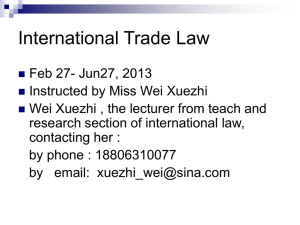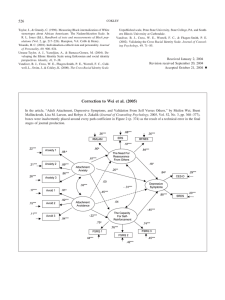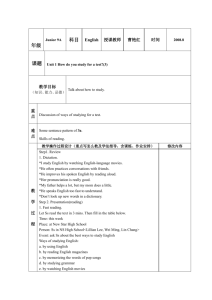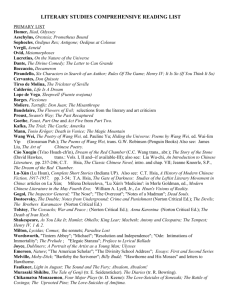Taoyuan Wei
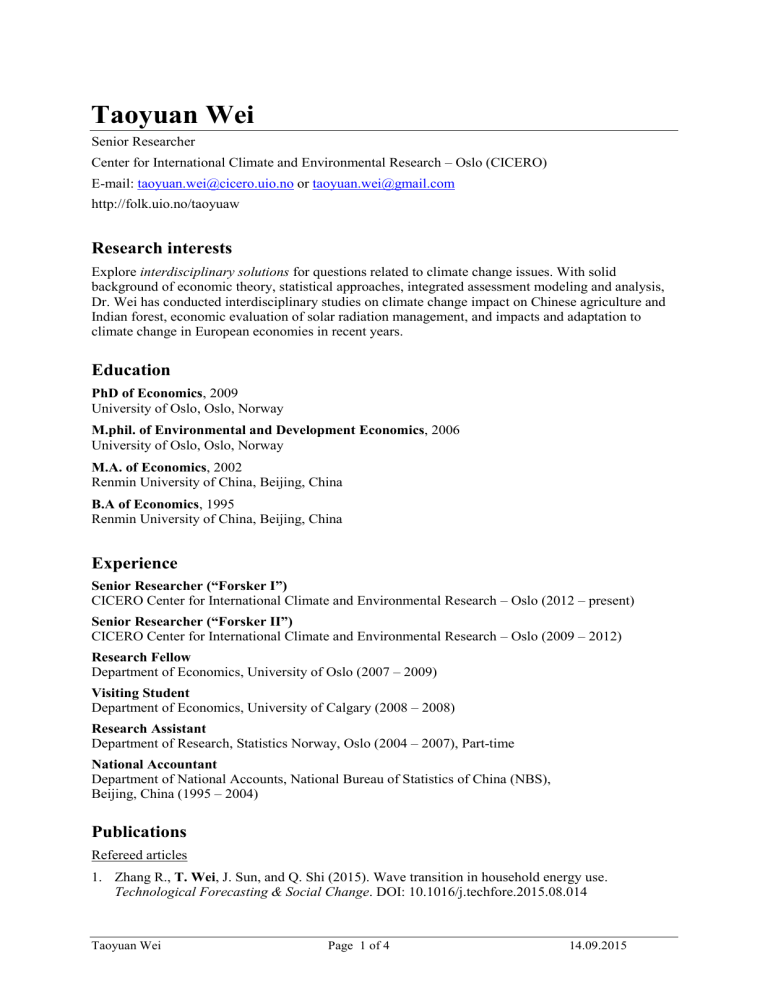
Taoyuan Wei
Senior Researcher
Center for International Climate and Environmental Research – Oslo (CICERO)
E-mail: taoyuan.wei@cicero.uio.no
or taoyuan.wei@gmail.com
http://folk.uio.no/taoyuaw
Research interests
Explore interdisciplinary solutions for questions related to climate change issues. With solid background of economic theory, statistical approaches, integrated assessment modeling and analysis,
Dr. Wei has conducted interdisciplinary studies on climate change impact on Chinese agriculture and
Indian forest, economic evaluation of solar radiation management, and impacts and adaptation to climate change in European economies in recent years.
Education
PhD of Economics , 2009
University of Oslo, Oslo, Norway
M.phil. of Environmental and Development Economics , 2006
University of Oslo, Oslo, Norway
M.A. of Economics , 2002
Renmin University of China, Beijing, China
B.A of Economics , 1995
Renmin University of China, Beijing, China
Experience
Senior Researcher (“Forsker I”)
CICERO Center for International Climate and Environmental Research – Oslo (2012 – present)
Senior Researcher (“Forsker II”)
CICERO Center for International Climate and Environmental Research – Oslo (2009 – 2012)
Research Fellow
Department of Economics, University of Oslo (2007 – 2009)
Visiting Student
Department of Economics, University of Calgary (2008 – 2008)
Research Assistant
Department of Research, Statistics Norway, Oslo (2004 – 2007), Part-time
National Accountant
Department of National Accounts, National Bureau of Statistics of China (NBS),
Beijing, China (1995 – 2004)
Publications
Refereed articles
1.
Zhang R., T. Wei , J. Sun, and Q. Shi (2015). Wave transition in household energy use.
Technological Forecasting & Social Change . DOI: 10.1016/j.techfore.2015.08.014
Taoyuan Wei Page 1 of 4 14.09.2015
2.
Aaheim, A., B. Romstad, T. Wei , J. E. Kristjánsson, H. Muri, U. Niemeier and H. Schmidt (2015).
An economic evaluation of solar radiation management. Science of the Total Environment 532:
61-69. DOI: 10.1016/j.scitotenv.2015.05.106.
3.
Underdal, A. and T. Wei (2015). Distributive fairness: a mutual recognition approach
Environmental Science and Policy 51: 35-44. doi: 10.1016/j.envsci.2015.03.009.
4.
Wei, T.
, S. Glomsrød, and T. Zhang (2015). Extreme weather, food security and the capacity to adapt - the case of crops in China. Forthcoming Food Security . doi: 10.1007/s12571-015-0420-6.
5.
Zhu, Q, and T. Wei (2014). Household energy use and carbon emissions in China: A decomposition analysis, Forthcoming Environmental Policy and Governance .
6.
Liu, Y. and T. Wei (2014). Linking the emissions trading schemes of Europe and China -
Combining climate and energy policy instruments.” Mitigation and Adaptation Strategies for
Global Change , doi: 10.1007/s11027-014-9580-5
7.
Glomsrød, S., T. Wei , T. Mideksa and B. Samset (2014). Energy market impacts of nuclear power phase-out policies, Mitigation and Adaptation of Strategies for Global Change . doi:
10.1007/s11027-014-9558-3.
8.
Wei, T . (2014). Accounting price of an exhaustible resource: A comment. Environmental and
Resource Economics . doi: 10.1007/s10640-014-9780-1.
9.
Zhang, R., T. Wei , S. Glomsrød, and Q. Shi (2014). Bioenergy consumption in rural China:
Evidence from a survey in three provinces, Energy Policy . doi: 10.1016/j.enpol.2014.08.036
10.
Wei, T , T. Cherry, S. Glomsrød, and T. Zhang (2014). Climate change impacts on crop yield:
Evidence from China, Science of the Total Environment , 499, 133-140. doi:
10.1016/j.scitotenv.2014.08.035.
11.
Wei, T , Q. Zhu, S. Glomsrød (2014). Energy spending and household characteristics of floating population: Evidence from Shanghai, Energy for Sustainable Development , 23, 141-149. doi:
10.1016/j.esd.2014.07.001.
12.
Wei, T . (2013). Comparing approaches to valuing sectoral net investments. Resource and Energy
Economics 35 (3) 316-328. doi: 10.1016/j.reseneeco.2013.03.002.
13.
Glomsrød, S., T. Wei , and K. Alfsen (2013). Pledges for climate mitigation: The effects of the
Copenhagen Accord on CO2 emissions and mitigation costs, Mitigation and Adaptation of
Strategies for Global Change , 18 (5), 619-636. doi: 10.1007/s11027-012-9378-2.
14.
Aaheim, A., H. Amundsen, T. Dokken, and T. Wei (2012). Impacts and adaptation to climate change in European economies, Global Environmental Change* 22 (2012) 959–968, doi:
10.1016/j.gloenvcha.2012.06.005.
15.
Wei, T . (2012). Capital gains and income arising from nonrenewable resources. Environmental and Resource Economics 52 (2) 293-300. doi: 10.1007/s10640-011-9531-5.
16.
Wei, T . (2012). Stochastic National Income. Journal of Reviews on Global Economics Vol.1 pp.112-123. doi: 10.6000/1929-7092.2012.01.10.
17.
Wei,T . (2011). What STIRPAT tells about effects of population and affluence on the environment ?
Ecological Economics 72 (2011): pp.70-74. doi:10.1016/j.ecolecon.2011.10.015
18.
Aaheim, A., R. Gopalakrishnan, R.K. Chaturvedi, N. H. Ravindranath, A. D. Sagadevan, N.
Sharma, and T. Wei (2011). A macroeconomic analysis of adaptation to climate change impacts on forests in India . Mitigation and Adaptation Strategies for Global Change 16: pp. 229-245
19.
Glomsrød, S., T. Wei , G. Liu, and J.B. Aune (2011). How well do tree plantations comply with the twin targets of the Clean Development Mechanism? -The case of tree plantations in Tanzania.
Ecological Economics 70: pp. 1066-1074.
Taoyuan Wei Page 2 of 4 14.09.2015
20.
Wei, T.
(2010). A general equilibrium view of global rebound effects.
Energy Economics 32: pp.
661-672
21.
Asheim, G.B. and Wei, T.
(2009). Sectoral income.
Environmental and Resource Economics 42: pp. 65-87.
22.
Wei, T.
(2007). Impact of energy efficiency gains on output and energy use with Cobb–Douglas production function , Energy Policy 35: pp. 2023-2030.
23.
Glomsrød, S. and Wei, T.
(2005). Coal cleaning: a viable strategy for reduced carbon emissions and improved environment in China? Energy Policy 33: pp. 525-542.
Journal articles in Chinese
1.
Zhu, Q and T. Wei (2015). Quantitative Analysis of Age Pattern of Household Consumption in
Urban and Rural China. Population Research 39(3): 3-17.
2.
Fan, M., T. Wei , X. Zhang, Y. Zhang (2015). The Composite Effects of Policy Mix for Low-
Carbon Development — A Dynamic CGE Modeling and Cost Effective Analysis for Beijing Case.
Industrial Economy Review Volum 2.(7) s. 31-47 DOI: 10.11970/j.issn.2095-7866.2015.01.004
3.
Zhu, Q. and T. Wei (2013). Impact of Urbanization on Carbon Emissions from Perspective of
Residential Consumption. China Population Resources and Environment 2013, 23(11) pp. 24-32.
4.
Fu, X., G. Wang, and T. Wei (2011). Structural Decomposition on Carbon Emission Intensity of
Shanghai. Resources Science 33 (11/2011) pp. 2124-2130. (ISSN: 1007-7588) http://www.resci.cn/ch/reader/view_abstract.aspx?file_no=20111114&flag=1
5.
He, X. and T. Wei (2002a). Impacts on Chinese economy of the world oil price rise. Economic
Theory and Business Management (Issue 4/2002). Renmin University of China.
6.
He, X. and T. Wei (2002b). World oil price change: effects and countermeasure. International
Economic Cooperation (No. 194, Feb. 2002). Ministry of Foreign Trade and Economic
Cooperation, PRC.
7.
Wei, T.
(2002). The influence of a rise in world oil price on Chinese economy. Quantitative &
Technical Economics (Issue 5/2002).
Chinese Academy of Social Sciences.
8.
Glomsrød, S. and T. Wei (2002). The impact of carbon tax on the Chinese economy and reductions of greenhouse gases. World Economics and International Politics (Issue 8/2002).
Chinese Academy of Social Sciences.
9.
Jiao, J. and T. Wei (2003). The effects of import & export on GDP at constant prices. Statistical
Research (Issue 10/2003). National Bureau of Statistics of China.
Digital compendium on the web
Aaheim; A. and T. Wei (2009). Macro-economic analysis – Model Output. The ADAM Digital
Compendium. Available at http://adam-digital-compendium.pik-potsdam.de/macro-economicanalysis/model-output/
Documents on statistics
1.
Wang, Y. and T. Wei (1999). The energy account in China: a technical. Documents 99/7,
Statistics Norway, Research Department. 1999.
2.
Chen, J., T. Zhao and T. Wei (2005). Chapter 4: Annex. Compilation methods for Input-output
Table 2002 of China , edited by Department of National Accounts, NBS, China Statistical Press.
2005, in Chinese.
3.
Training Manual of National Input-output Survey 2002 (Participated), edited by Department of
National Accounts, NBS, China Statistical Press. Published in Chinese.
Taoyuan Wei Page 3 of 4 14.09.2015
4.
Input-output Tables 1997 of China (Participated), edited by Department of National Accounts,
NBS, China Statistical Press .
2000. Published in Chinese.
5.
Input-output Tables 1995 of China (Participated), edited by Department of National Accounts,
NBS, China Statistical Press. 1998. Published in Chinese.
Main project activities
1.
2015 – 2016. “Energy efficiency policies in emerging economies to promote economic growth and climate mitigation.” External finance: Research Council of Norway. Project Leader
2.
2015 – 2018. “Ageing population and social reforms in China: Consequences for economic growth and global climate.” External finance: Research Council of Norway. Work Package Leader
3.
2014. “Implications of ageing and urbanization in China for economic growth and climate.”
External finance: Research Council of Norway. Project Leader
4.
2013. “Rebound effects in Chinese electricity sector.” External finance: Research Council of
Norway. Project Leader
5.
2012 – 2015 “Climate change and adaptation in the forest plantation sector – an ecological and economic assessment for India.” external finance: Research Council of Norway. Project
Participant
6.
2012 – 2015 “Climate change and Chinese agriculture: Effects on food production and options for adaptation.” Joint external finance: Research Council of Norway and Chinese Academy of
Sciences. Work Package Leader
7.
2012 – 2015. “Tool-supported policy-development for regional adaptation (TopDad).” External finance: the European Union's Framework-7 Programme (FP7). Project Participant
8.
2011 – . “CICEP - Strategic Challenges in International Climate and Energy Policy” (FME center). Main external finance: Research Council of Norway. Project Participant
9.
2011 – 2014. The JORDMOD project: “Strategies to reduce greenhouse gas emission in
Norwegian agriculture.” External finance: Research Council of Norway. Project Participant
10.
2009 – 2013. The IMPLICC project: “Implications and risks of engineering solar radiation to limit climate change” 2007-2013. External finance: the European Union's Framework-7 Programme
(FP7). Project Participant
11.
2010 – 2013. “Large developing economies: current and potential future contributions to climate change.” External finance: Research Council of Norway. Work Package Leader
12.
2009- 2011. “Domestic and petroleum sector implications of different international climate regimes” 2008-2011. External finance: StatoilHydro. Project Participant
13.
2009. The ADAM project: “Adaptation and Mitigation Strategies Supporting European Climate policy” 2006 – 2009. External finance: the European Community's Framework 6 Programme
(FP6). Project Participant
14.
2009. The ENSEMBLES project: “integrating climate change impacts studies into an ensemble prediction system.” 2004 – 2009. External finance: the European Community's Framework 6
Programme (FP6). Project Participant
15.
2009. “Impact of Climate Change on Tropical Forest Ecosystem and Biodiversity in India.” 2007
– 2009. External finance: Royal Norwegian Embassy in New Delhi, India. Project Participant
16.
1997 – 2001: “Environmental statistics and analysis.” Co-operation between Statistics Norway and National Bureau of Statistics of China. External finance: The Norwegian Agency for
Development Cooperation (NORAD). Work Package Leader
Taoyuan Wei Page 4 of 4 14.09.2015
